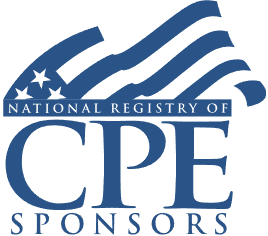Charitable Giving and the CARES Act: 100% AGI Limitation, Donating Appreciated Property
CLATs and GRATs, Taking Advantage of Low IRS Section 7520 Interest Rates

Welcome! Strafford is now BARBRI! The expert courses you know from the trusted global leader in legal education.
Course Details
- smart_display Format
On-Demand
- signal_cellular_alt Difficulty Level
Intermediate
- work Practice Area
Tax Preparer
- event Date
Tuesday, July 28, 2020
- schedule Time
1:00 p.m. ET./10:00 a.m. PT
- timer Program Length
110 minutes
-
BARBRI is a NASBA CPE sponsor and this 110-minute webinar is accredited for 2.0 CPE credits.
-
BARBRI is an IRS-approved continuing education provider offering certified courses for Enrolled Agents (EA) and Tax Return Preparers (RTRP).
This course will discuss recent changes to charitable contributions and explain how to maximize tax savings by making charitable gifts. Our panel of tax experts will discuss donating appreciated property, utilizing the 100% AGI limitation, and establishing a charitable lead annuity trust (CLAT), as well as other strategies for charity donations, considering the current economic environment.
Faculty

Mr. LaBrecque’s practice is focused on the cutting edge of a diverse range of planning tools, growth and wealth management strategies. He uses these tools to ensure business owners and individuals alike receive the very best in investment and wealth management services. Mr. LaBrecque’s practice is continually growing in breadth and depth of client offerings to connect clients and potential clients to new and expanded opportunities for growing their wealth, protecting future resources, and propagating financial literacy through families and our communities.

Mr. Laubacher assists high net worth individuals, entrepreneurs, and multi-generational family businesses in sorting out their complicated situations and plan for their ultimate goals. After developing customized financial strategies and wealth transfer plans, he regularly reevaluates clients' objectives to ensure the intended results based on their planning strategies.
Description
Myriad changes relative to charitable giving force practitioners to take a fresh look at giving strategies under the new paradigm. The 2017 tax act, the SECURE Act, and most recently, the CARES Act, all impact the benefits of charitable giving. Additionally, the state of the current economy has opened-up unique opportunities for charitable giving.
The 2017 tax law increased the adjusted gross income limitation from 50% to 60% for charitable donations. The CARES Act increased the limitation again to 100% for 2020. The prior restrictions on gifts of appreciated property (30%), however, remain in place, and contributions to donor-advised funds are subject to the old limit (60%). Knowing who benefits from the increased limitations and how to incorporate charitable carryforwards is key to maximizing the benefits of the increased limitation.
Some of the most beneficial strategies take advantage of the incredibly low Section 7520 rate (.8%, May 2020). This, coupled with the decrease in asset values, could make this the perfect time to establish a CLAT.
Listen as our charitable giving experts point how charitable giving can save significant tax dollars in the current economic environment.
Outline
- Overview
- Recent Acts
- Tax Act of 2017
- SECURE Act
- CARES Act
- Qualified charitable distributions
- Donating appreciated property
- Utilizing the new AGI limitations
- Roth conversion with charitable offset
- Taking advantage of the 7520 rate
- Other charitable giving considerations
Benefits
The panel will discuss these and other pertinent issues:
- The effects of recent tax acts on charitable giving
- Combining a ROTH conversion with a charitable giving offset
- Establishing a CLAT to maximize tax-free transfers
- Considerations when utilizing the 100% AGI limitation
NASBA Details
Learning Objectives
After completing this course, you will be able to:
- Identify changes made to charitable donations under the CARES Act
- Ascertain which taxpayers could benefit from a ROTH conversion with a charitable offset
- Determine how to establish a CLAT
- Decide the tax effects of gifting appreciated property
- Field of Study: Taxes
- Level of Knowledge: Intermediate
- Advance Preparation: None
- Teaching Method: Seminar/Lecture
- Delivery Method: Group-Internet (via computer)
- Attendance Monitoring Method: Attendance is monitored electronically via a participant's PIN and through a series of attendance verification prompts displayed throughout the program
- Prerequisite: Three years+ business or public firm experience preparing complex tax forms and schedules, supervising other preparers or accountants. Specific knowledge and understanding of pass-through taxation, including taxation of partnerships, S corporations and sole proprietorships, qualified business income, net operating losses and loss limitations; familiarity with net operating loss carry-backs, carry-forwards and carried interests.

Strafford Publications, Inc. is registered with the National Association of State Boards of Accountancy (NASBA) as a sponsor of continuing professional education on the National Registry of CPE Sponsors. State boards of Accountancy have final authority on the acceptance of individual courses for CPE Credits. Complaints regarding registered sponsons may be submitted to NASBA through its website: www.nasbaregistry.org.

Strafford is an IRS-approved continuing education provider offering certified courses for Enrolled Agents (EA) and Tax Return Preparers (RTRP).
Unlimited access to premium CLE courses:
- Annual access
- Available live and on-demand
- Best for attorneys and legal professionals
Unlimited access to premium CPE courses.:
- Annual access
- Available live and on-demand
- Best for CPAs and tax professionals
Unlimited access to premium CLE, CPE, Professional Skills and Practice-Ready courses.:
- Annual access
- Available live and on-demand
- Best for legal, accounting, and tax professionals
Unlimited access to Professional Skills and Practice-Ready courses:
- Annual access
- Available on-demand
- Best for new attorneys
Related Courses

Redemptions of Partnership Interests: Sections 736(b) vs. 736(a)
Friday, October 31, 2025
1:00 p.m. ET./10:00 a.m. PT

Multistate Tax Treatment of Multi-Tier Partnerships: Ingesting PTET in a Multi-Tier Entity
Friday, September 19, 2025
1:00 p.m. ET./10:00 a.m. PT

IRA Distributions and RMDs: Minimizing Taxes and Meeting SECURE 2.0 Requirements
Available On-Demand

Avoiding Gift and Estate Audit Triggers: Anticipating Audit Issues, IDRs, and Appeals
Tuesday, September 9, 2025
1:00 p.m. ET./10:00 a.m. PT
Recommended Resources
How CPE Can Bridge the Gap Between What You Know and What You Need to Know
- Career Advancement